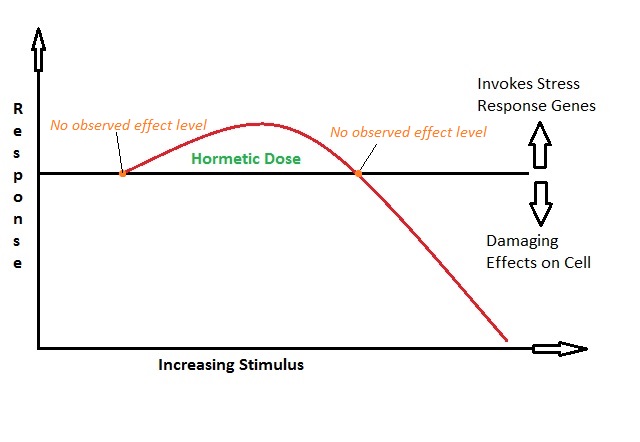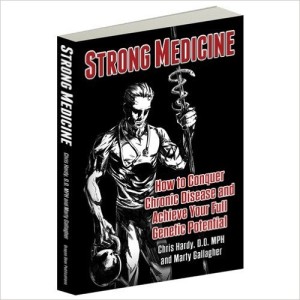You may be asking yourself what in the world hormesis is, and that’s okay, at least you’re asking, because once you know, and you use it to your advantage, your plan to achieve your body composition and performance goals will be within reach. Do I have your attention? Good, let’s begin…
Let’s start with Wikipedia, the world’s greatest source of information- ummm, or something like that:
Hormesis is the term for generally favorable biological responses to low exposures of toxins and other stressors. A pollutant or toxin showing hormesis thus has the opposite effect in small doses as in large doses.
So what’s that mean? Some things are beneficial in small to moderate amounts, but become toxic in higher amounts. Think of medicine. Taking the bottle of Ibuprofen will possibly kill you, but the recommended amount will likely clear your headache. What we’re after is just the right amount to handle our issue, and no more. Maybe you’ve heard of the minimum effective dose.
Let’s use a picture to help this all make sense:
Like Ibuprofen, exercise has ideal doses, but it’s a little more of a moving target. There’s not necessarily a negative response to avoiding Ibuprofen, but there is to avoiding physical activity. In this case, too little AND too much can be toxic.
An Image may help again here:
So too little physical activity can be toxic, and I think we all know that- but so can too much. You can see the “sweet spot,” or hormetic dose pictured above, but even that only tells part of the story…
There’s a lot of factors that come into play when it comes to physical activity. To dig deeper into that, let’s define a few terms:
- Intensity: Percentage of one rep max, or rate of perceived exertion (RPE, simply a scale of 1-10, 1 being no exertion at all, 10 being the hardest thing you could do)
- Volume: The total amount of work completed per session
- Density: Amount of work done in a given time (same work done in less time = higher density)
- Frequency: How often you expose yourself to physical activity
All of these facets of physical activity, especially when it comes to planned exercise, have an impact on the acquisition of our goal(s). As you can imagine, if we turn all of them up to 10/10, we’re most certainly looking at a toxic dose of exercise, and it will be apparent in a short period of time. So too will too little…
One of the best analogies I’ve heard to help you understand this concept was from Master SFG, “Iron Tamer” Dave Whitley. We’re all familiar with sun tanning. Too much, not good. Too little, you look like me and my dude Todd Bumgardner.


And then you’ve got to take into account where you are. We all know the sun is completely different in the north as opposed to the south (i.e. Ocean City, Maryland vs. Miami, Florida).
You (not me or Todd) can probably handle quite a bit of sun exposure in Ocean City, but you’d have to be a little more careful in Miami. The differences could be spending less time in the sun (lower volume, high intensity), or wearing sunscreen (the sun screen represents stress reduction techniques, while dealing with high volume) while in Miami. You can spend more time in the sun in Ocean City because the sun is not intense, thus allowing you to handle more volume.
Taking it a step further, think about a tanning bed. Now we’ve got a VERY high intensity exposure, but the volume is much lower to yield the same results, therefore increasing the density of the session. If you ignored these concepts and went into the tanning bed for hours like you did at the beach, I’m not suuuuure, but I think it’s safe to say you will die on the spot.
Finally, frequency of tanning comes into the picture. We can use a higher frequency of low volume and high intensity exposure to the sun or tanning bed to build up a good tan, and over time we can handle higher volumes of exposure. We could also expose ourselves to a higher frequency of low volume and low intensity to build up to more. However, remember hormesis! There is a point of diminishing returns here.
But don’t forget, too little of all of this, and you look Powder.

So what’s this got to do with your goal(s)?
Well, that depends on your goal(s) really! But whatever your goal(s) are, you’ve got to keep these concepts in mind. If your goal(s) require a higher intensity approach, a volume approach, a higher density approach, and/or a higher frequency approach, you have got to have balance and make sure you are supplying your systems a hormetic dose!
You could use this information to create endless variance to your exercise routine. Take the following example:
- Phase One: Moderate Intensity (RPE of 6-8), Moderate Volume (2-3 super-sets of 8-12 reps), Low-Moderate-Low Density (prescribed rest periods allowing nearly full recovery between sets), and Frequency (4 days per week).
[The main thing that would change/progress throughout the phase here would be weight, which is a component of intensity]
- Phase Two: Moderate Intensity (RPE of 6-8), Moderate Volume (2-3 super and tri-sets of 6-10 reps), Increasing Density (Progressing from prescribed rest periods allowing nearly full recovery between sets in week 1 through shorter and shorter rest periods in weeks 2-4), and Frequency (4 days per week).
[The main change/progression in this phase would be decreasing rest, or more work in less time week to week, therefore increasing the density of the sessions]
- Phase Three: Moderate-High Intensity (RPE of 7-9), Low-Moderate Volume (2-3 super and tri-sets of 3-6 reps), Low Density (prescribed rest periods allowing full recovery between sets), and Frequency (4 days per week).
[The main change this phase is intensity again, as well as volume. With the jump to moderate-high intensity we had to drop volume a little bit as well so that we could still withstand the frequency of training]
Notice in the examples above, that as one thing increased, another typically decreased to account for the change. Is this to say that we can never increase everything? No! You sure can, but there’s a cost to doing business, and the dose MIGHT become toxic. You could apply the sunscreen (stress reduction techniques) during all around intense phases, but you have to be careful! Whether that toxicity becomes apparent in mere weeks, or the stress builds up too much over the year, it might be too much.
Regardless of the goal(s), consistency is key. And if we train with more than the minimum effective dose often, bad things can happen. When bad things happen, we may be forced to lose consistency. When we lose consistency, our goals fall further from our reach.
Remember the hormetic dose.
If this topic (stress and health) interests you, I can not recommend the book “Strong Medicine” enough. Go check it out!
Latest posts by Chris Merritt (see all)
- Why Your Favorite Instagram Model’s Butt Program is a Waste of Time - 2017/08/30
- The ABC’s of the Kettlebell Swing - 2017/08/23
- I’m New to the Gym, What Should I Do? - 2017/08/16



